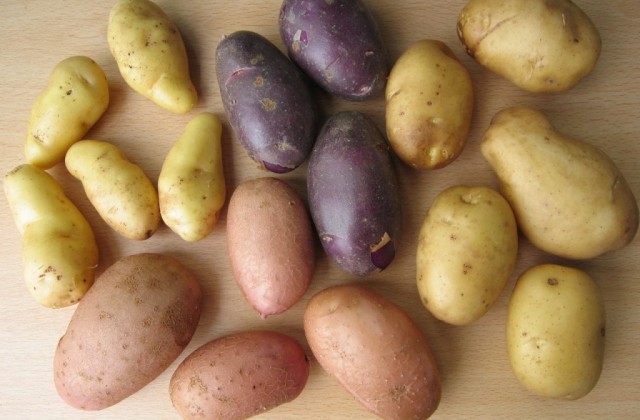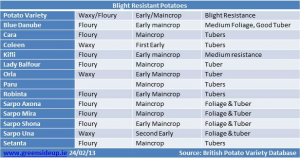Sourcing non-gm naturally blight resistant SPUDS in 2013

Many people are asking us where they can buy blight resistant potato seed this year. These potatoes are readily available off the shelf from many retailers including: The Organic Centre, Fruithill Farms, GIY Ireland , The Secret Garden, and Irish Seed Savers (free with membership while supplies last!). In fact many mainstream garden supply shops carry blight resistant varieties, for example Mr. Middleton sells the varieties we gave away last year: Sarpo Mira, Axona and Blue Danube.
We recommend ordering/buying ASAP…Our preliminary findings show that 95% of SPUDS growers who trialed resistant Sarpo varieties in 2012 would like to grow them again this year and due to the unusually difficult growing season last year potato seed will be limited.
If you are interested in trailing larger quantities of blight resistant seed you will need to MOVE FAST, stocks are dwindling!
Are you an organization or commercial grower or even a GIY group who would like to buy in quantity and save money for your members? Fruithill Farms sell blight resistant varieties in 25 kilo bags and ships countrywide. They also can help you read your soil tests and advise on soil improvements to help boost your potato production and are more than willing to answer specific questions about these varieties which they have supplied to commercial organic growers for many years now.
A recent entry on Greenside Up’s blog: “Will You Ditch the Chemicals and Choose Blight Resistant Potatoes This Year?” includes a useful table listing resistant varieties which has been extracted from the British Potato Variety Database. This comprehensive source provides information on both foliage and tuber resistance to blight as well as many other characteristics of the listed varieties. This is useful because some potato varieties, the Blue Danube for example, have foliage that is less resistant to blight but tubers that are extremely resistant. If these varieties contract blight you should wait until apx. 10% of the plants are effected, then cut off the tops and leave the tubers in the ground for 3 weeks to allow the spuds to mature and avoid spreading blight spores.
There are at least two blight resistant varieties that came up last year in our study which are not on this table:
Bionica: An early main crop variety which has high blight resistance and is grown commercially and sold by Keoghs of Oldtown. Fruithill Farms carry this variety.
Tibet: The story is that this variety traveled to the UK in the pocket of a traveler returning from Nepal and has gradually made it’s mark as a flavorsome blight resistant variety. Organic grower Dermot Carey raves about this variety which was still flourishing and flowering in one of his gardens into November of last year. Irish Seed Savers have limited stocks of this variety available with membership.
If you are retailing naturally blight resistant spuds, or know of a supplier we haven’t mentioned, please send us contact details so that we can update our information!
 Desireland
Desireland

Hi Kaethe, Thanks for the link. I’ve been encouraging all the gardeners I work with to sow and grow blight resistant potatoes and it was a topic for conversation this morning at the community garden. Some garden centres still aren’t stocking any and the only varieties they were able to find hunting around were Colleen, Una and the Sharpo Miras and Axona’s.
The other interesting thing (I found) was that of 16 gardeners, none had heard that there was a blight resistant option (they do now) and they will all be growing them in their gardens this year as well as the community gardens. A lot of it is about getting the word out to everyone that there are alternatives to spraying as they all wished to try them (especially once they heard there were floury options). Hopefully with more people asking for blight resistant, more garden centres will stock and promote them. Keep up the great work!! Dee
I really appreciate your comments Dee! You are absolutely right. When I launched SPUDS last year and began offering people blight resistant potato seed, I was actually accused of trying to push Genetically Modified (GM) potatoes on growers, (precisely the opposite of what I was doing)! Based on the way Teagasc’s application to trial GM blight resistant potatoes was presented to the public, many people were lead to believe there was no alternative.
In fact, many people were unaware that blight was still a problem. They felt it had disappeared with the famine. This is no surprise when you consider the enormous gap that now exists between the consumer and the producer, which I believe to be the greatest obstacle to developing a sustainable food system. Most of us have no idea what challenges the farmers are up against and how many chemicals are required to met the supermarket’s demand for ‘perfect’ food. In the case of potato farmers, they spend as much on fungicides as they do on seed.
If people did know about blight resistant varieties they were convinced that you would have to sacrifice taste. I think this misconception may have been based on Sarpo Mira which can be waxy, floury or starchy and hollow depending when you harvest it. The trick is knowing your variety and it’s particular characteristics. Even the Rooster, which is not a particularly floury potato, was not very popular when it was first introduced, but it is now the standard against which everything else is judged!
Over 90% those who took part in SPUDS last year didn’t get blight, loved the flavor of the blight resistant varieties we gave away, and are anxious to buy them to grow again this year. So, you are right again! The trick is to get the word out: there are tried and tested, commercially viable, alternatives to spraying.
In fact, the Sarpo varieties are also virus resistant, drought resistant, store at higher temperatures and have profuse weed suppressant foliage, ticking all the boxes necessary to lower our carbon footprint.
So why, I ask, is someone fooling around with reintroducing the ‘Lumper’ when we are promoting ‘Origin Green’ and Ireland as the home of sustainable food products?
http://www.irishtimes.com/newspaper/frontpage/2013/0302/1224330699102.html
I have grown blue danube in my garden this year because I was told that they were blight resistant. Now I discover that they are 50/75% infected with blight, almost a complete wipe out.
I am sorry you have been disappointed. Blue Danube are Blight Resistant, but not as resistant as other varieties, Sarpo Mira for example. In fact no variety is Blight FREE. Whether you get blight or not depends on so many factors, the weather conditions and what was grown in your soil prior to this year being a major influences. Were potatoes grown in your plot previously?
The good thing is that Blue Danube have higher tuber resistance, so even if the plant is effected the tubers may be just fine. You should remove the tops (burn them or compost them at a high temperature) then let the tubers remain in the soil for at least 3 weeks to avoid spreading the blight spores and to allow the skins to mature. Depending on when you planted the potatoes, and how well they were nourished and watered, you may harvest a decent crop.
I hope this is helpful. Please let us know how you get on with you eventual harvest.
Kaethe
Hopefully that’s more headline than substance Kaethe! Lets hope that all the folk growing blight resistant have a fabulous harvest this year and go away and tell all their friends and neighbours!!
Actually, that seems to have already happened. The demand is escalating! I am presenting the SPUDS project at Potato Day at the Organic Organic Centre on Sunday and hope they will agree to distribute some larger quantities if we can secure them. Crops were low last year!
By the way. Two Blight resistant varieties that are being mentioned which are not on your chart or the UK database are:
Bionica: Currently being grown on a large scale for Keoghs by a commercial organic farmer. Some say this is as resistant as the Sarpo Mira.
Tibet: Cultivated by seed savers and has been very successful for several people I have met including organic market gardener Dermot Carey who is taking over managing the Lissadell/Langford potato collection. He sent me photos of Tibet still flourishing and flowering in November…I also had a Blue Danube still in flower at the time!